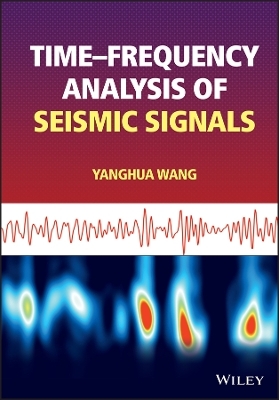
Time-frequency Analysis of Seismic Signals
John Wiley & Sons Inc (Verlag)
978-1-119-89234-2 (ISBN)
Time–frequency analysis of seismic signals aims to reveal the local properties of nonstationary signals. The local properties, such as time-period, frequency, and spectral content, vary with time, and the time of a seismic signal is a proxy of geologic depth. Therefore, the time–frequency spectrum is composed of the frequency spectra that are generated by using the classic Fourier transform at different time positions.
Different time–frequency analysis methods are distinguished in the construction of the local kernel prior to using the Fourier transform. Based on the difference in constructing the Fourier transform kernel, this book categorises time–frequency analysis methods into two groups: Gabor transform-type methods and energy density distribution methods.
This book systematically presents time–frequency analysis methods, including technologies which have not been previously discussed in print or in which the author has been instrumental in developing. In the presentation of each method, the fundamental theory and mathematical concepts are summarised, with an emphasis on the engineering aspects.
This book also provides a practical guide to geophysicists who attempt to generate geophysically meaningful time–frequency spectra, who attempt to process seismic data with time-dependent operations for the fidelity of nonstationary signals, and who attempt to exploit the time–frequency space seismic attributes for quantitative characterisation of hydrocarbon reservoirs.
Yanghua Wang is a Professor of Geophysics at Imperial College London and the Director of the Resource Geophysics Academy. He is a Fellow of the Royal Academy of Engineering (FREng). He has received the Conrad Schlumberger Award (2021) from the European Association of Geo-scientists & Engineers for his scientific contribution to geophysics.
Preface viii
1 Nonstationary signals and spectral properties 1
1.1 Stationary signals 1
1.2 Nonstationary signals 5
1.3 The Fourier transform and the average properties 7
1.4 The analytic signal and the instantaneous properties 10
1.5 Computation of the instantaneous frequency 13
1.6 Two groups of time-frequency analysis methods 17
2 The Gabor transform 19
2.1 Short-time Fourier transform 19
2.2 The Gabor transform 23
2.3 The cosine function windows 26
2.4 Spectral leakage 31
2.5 The Gabor limit of time-frequency resolution 33
2.6 Implementation of the Gabor transform 36
2.7 The inverse Gabor transform 40
2.8 Application in inverse Q Filtering 42
3 The continuous wavelet transform 47
3.1 Basics of the continuous wavelet transform 47
3.2 The complex Morlet wavelet 51
3.3 The Morse wavelet 54
3.4 The generalised seismic wavelet 58
3.5 The frequency representation 62
3.6 The inverse wavelet transform 64
3.7 Implementation of the continuous wavelet transform 66
3.8 Hydrocarbon reservoir characterisation 68
4 The S transform 73
4.1 Basics of the S transform 74
4.2 The generalised S transform 77
Time-Frequency vi Analysis of Seismic Signals
4.3 The fractional Fourier transform 79
4.4 The fractional S transform 83
4.5 Implementation of the S transform 86
4.6 The inverse S transform 88
4.7 Application to clastic and carbonate reservoirs 93
5 The W transform 95
5.1 Basics of the W transform 95
5.2 The generalised W transform 99
5.3 Implementation of nonstationary convolution 106
5.4 The inverse W transform 108
5.5 Application to detect hydrocarbon reservoirs 109
5.6 Application to detect karst voids 112
6 The Wigner-Ville distribution 117
6.1 Basics of the Wigner-Ville distribution (WVD) 117
6.2 Defining the WVD with the analytic signal 120
6.3 Properties of the WVD 123
6.4 The smoothed WVD 126
6.5 The generalised class of time-frequency representations 132
6.6 The ambiguity function and the generalised WVD 134
6.7 Implementation of the standard and smoothed WVDs 140
6.8 Implementation of the ambiguity function and the
generalised WVD 147
7 Matching pursuit 151
7.1 Basics of matching pursuit 151
7.2 Three-stage matching pursuit 153
7.3 Matching pursuit with the Morlet wavelet 157
7.4 The sigma filter 159
7.5 Multichannel matching pursuit 163
7.6 Structure-adaptive matching pursuit 168
7.7 Three applications 170
8 Local power spectra with multiple windows 175
8.1 Multiple orthogonal windows 176
8.2 Multiple windows defined by the prolate spheroidal
wave functions 178
8.3 Multiple windows constructed by solving a discretised
eigenvalue problem 180
8.4 Multiple windows constructed by Gaussian functions 184
8.5 The Gabor transform with multiple windows 187
8.6 The WVD with multiple windows 190
Contents vii
Appendices 195
A The Gaussian integrals, the Gamma function, and the
Gauss error functions 195
B The Fourier transform of the tapered boxcar window,
the truncated Gaussian window, and the Blackman
window 198
C The generalised seismic wavelet 201
D The fractional Fourier transform 203
E Marginal conditions and the analytic signal in the WVD
definition 204
F Prolate spheroidal wave functions and the associated
Legendre polynomials 209
References 215
Author index 223
Subject index 225
| Erscheinungsdatum | 28.10.2022 |
|---|---|
| Verlagsort | New York |
| Sprache | englisch |
| Maße | 176 x 247 mm |
| Gewicht | 680 g |
| Themenwelt | Naturwissenschaften ► Geowissenschaften ► Geologie |
| Technik ► Elektrotechnik / Energietechnik | |
| ISBN-10 | 1-119-89234-1 / 1119892341 |
| ISBN-13 | 978-1-119-89234-2 / 9781119892342 |
| Zustand | Neuware |
| Informationen gemäß Produktsicherheitsverordnung (GPSR) | |
| Haben Sie eine Frage zum Produkt? |
aus dem Bereich


